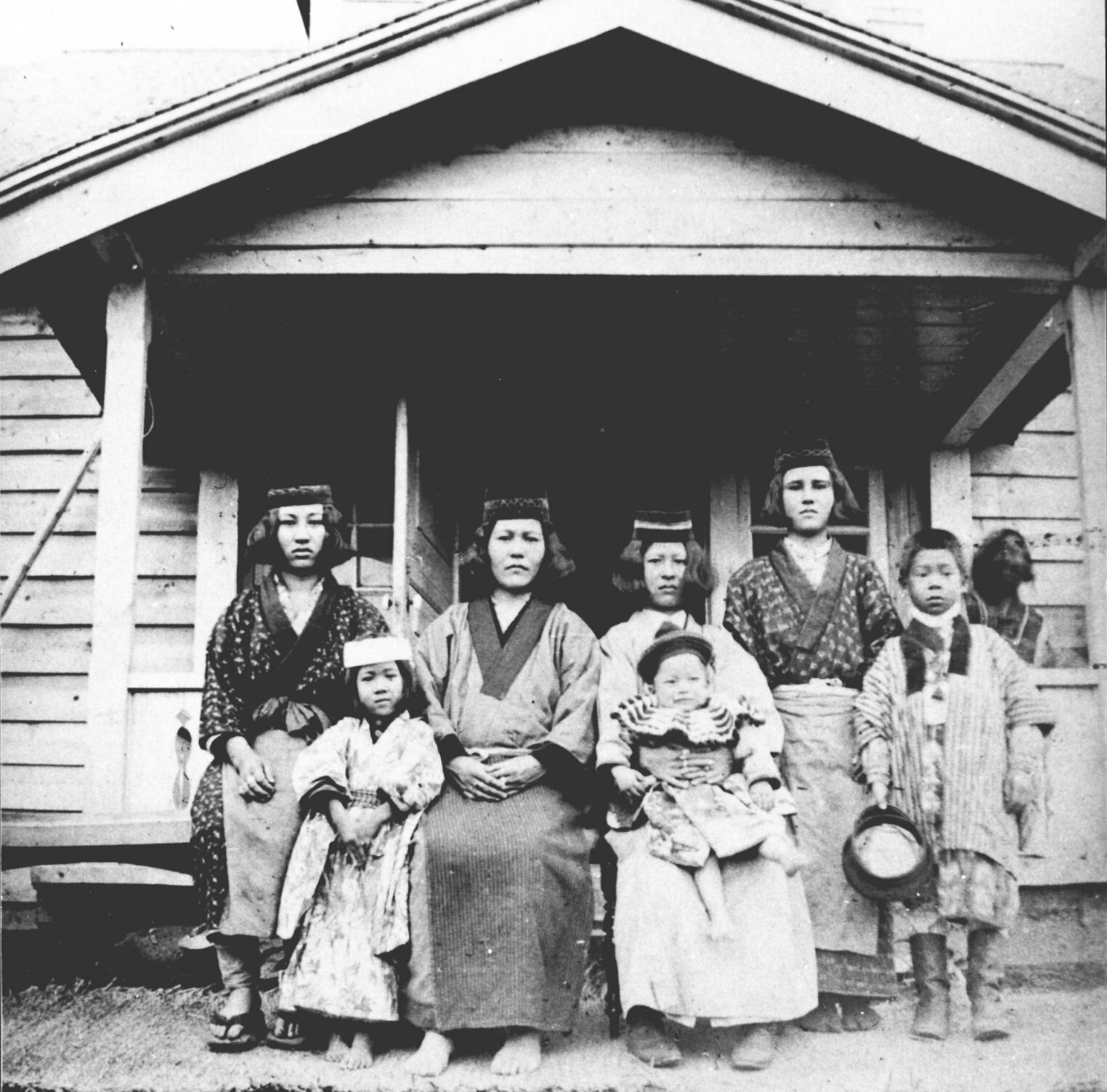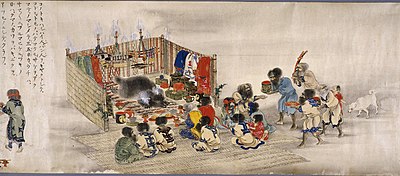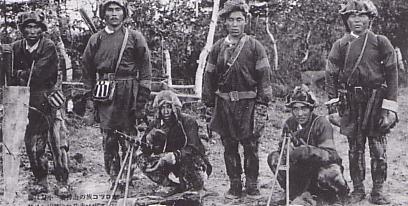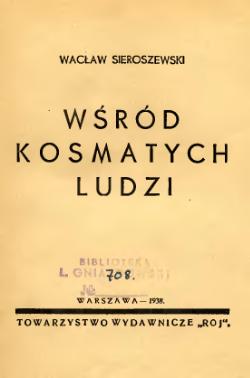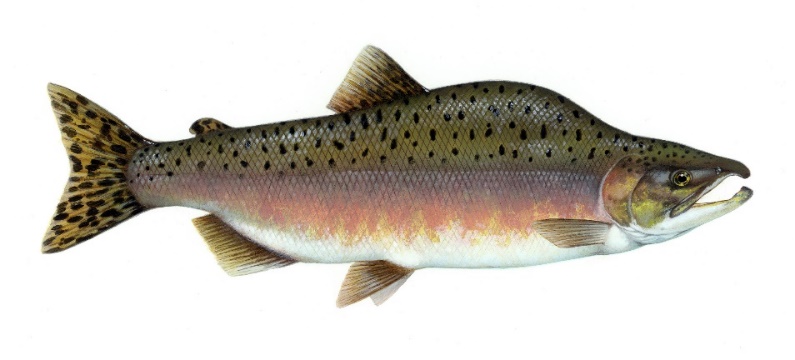
Ethnography
Story of an Ainu Man from Tarayka
Activities
In January 1903, Piłsudski wrote down a story he heard from Sishratoki about the battle between Ainu and Orok peoples. This is an extraordinary story about the successive phases of a ruthless war. One detail of the story is quite astounding. It tells about learning how to defend with bare hands against an attack by an archer. The climate of the story resembles that of Iliad.
Here is an excerpt:
Six nishpas (rich people) lived in a kotan (kotan is the Ainu word for village). One of them once wandered into the territory occupied by Oroks and went into an Oroc hut. There were a lot of deer that year. When the wealthy Ainu entered the Orok hut and sat by the fire, the Oroks gave him a deer stomach stained with impurities to eat. The rich Ainu took offense [not knowing that Orok people considered it a special delicacy and that he was honored in this way; JRCz] and refused to eat. He returned to Tarayka and told the other five rich men about the incident.
Then they all went to the Orok hut and slaughtered its inhabitants, men and women, without any exception. Only one boy managed to escape. He got on one of the grazing deer and rode on it to escape to the Orok village of Turisa which the Ainus call Uney located near the mouth of the Tym River. There he told the Oroks about what had happened. The Oroks then prepared many bows and many arrows.
Winter arrived. In the kotan named Taran, many people were busy ice-fishing on the lake, when suddenly a herd of deer came running. These deer were mounted by Oroks with quivers full of arrows strapped to their backs. The Oroks rode very close to the Ainus and started shooting at them. Since having gone fishing, the Ainus took nothing with them except fishing gear; the Oroks soon slaughtered all the Ainus. Only one Ainu, who did not have any fishing gear, started running towards Tarayka. The Oroks riding the deer began to chase him, but they could not catch up with this Ainu.
Just halfway between the Taran kotan and the mouth of the Tym River there was the grave of a man. The fleeing Ainu lifted the cover of the grave and took from it a bow reinforced with a bone lining, which people had once left for the dead in the grave, and two arrows lying there. He fixed the string, put on an arrow and started to wait for the approaching Oroks.
Behold, the Oroks approached. As the Ainu tightened the bow, the string broke and… he was left helpless, and could no longer do anything. The Oroks shot at him with their bows and killed him. Then they went to the Siska kotan on the river of the same name, near its confluence with the Poronay River. It was already dark. The residents of Siska lived in dugouts. The Oroks gathered a lot of dry grass, set it on fire, and threw it into the dugouts. The dugouts were burning fast. The Oroks tore off canopies covering the smoke stacks and threw burning grass in through the smoke openings, too. Thus, the Oroks burned down the entire village and no one survived. Then the Oroks moved on to Tarayka. In Tarayka, the six rich Ainus put on armor and kept watch day and night. When the Oroks arrived and saw the six nishpas so well prepared for battle and clad in armor, they became very frightened and fled across the lake on the ice. As they ran away, the Oroks reached the Nokoro kotan located next to Tarayka and killed everyone there. They then advanced along the coast of Tan Atui (the Ainu name for the Gulf of Patience – note by A.M.) to reach Karere (the Ainu name for the part of the Sea of Okhotsk north of Cape Patience – note by A.M.). The Ainus also lived in dugouts there. The Oroks set also fire to the grass there, and by throwing it into the dugouts, they burned them all. Then the Oroks took the women who seemed useful to them, and abducted them to their homes. There they married them and had children with them.
Since the Oroks abducted Ainu women from the Karere area as war trophies, and had children with them, the Ainus are now related to the Oroks. Now the hostilities between these two people have ceased. (…)
After all the events, two Ainus from Tarayka were learning how to fight. One got a bow, and the other stood at a distance; then many people stood in a row with bows. They put “blank” etanto arrows on the bows. At the signal given by a man standing some distance away, all the Ainus holding bows shot these [blank] arrows at him. None of the arrows reached the man, he avoided them all, and at the same time he caught many arrows with his hands. He escaped so that not a single arrow of the many shot toward him even touched him.
Because of what happened, the Ainus then used real arrows fitted with sharp metal tips. And again this Ainu escaped them so that not a single one of these many arrows even scratched him, while at the same time he caught many of them with his hands. (…)
Soon the Tarayka katan had two Ainus who were very well prepared for this kind of fighting, and all the other villagers were also strong and prepared for battle. They no longer feared an onslaught by the Oroks. They would be very happy to fight the Oroks if they started a war first. But the Ainus have been waiting like this until today for the Oroks to start a war, and for some reason the latter are not doing it. In the past, the Ainus used to cause harm to the Oroks, so later they had to let them win wars. That’s the way it used to be, but now the Ainus can’t start a fight first.
The legend mentions combat armor. Wealthy Ainus had Japanese armor, which they called sozoku or yoroy; however, they also used armor they manufactured themselves. They made it from ropes and nets tightly woven together and covered with a thick layer of clay; they called such armor kusari. They also made armor from the skin of a species of salmon, which was also covered with clay, and at that time it was called kepun hayufpe.
(Based on an excerpt from the History and Legends of the Ainus by Alfred Majewicz.)

